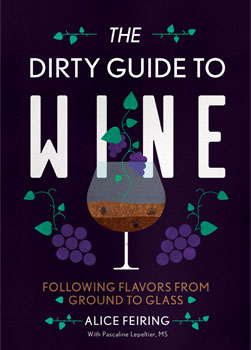

The Dirty Guide to Wine: Following Flavors from Ground to Glass
Author: by Alice Feiring
Publisher: Countryman Press, 2017
Price: $25
The world of wine goes through revolutions. The early 1990s saw the cult of the winemaker. Flying winemakers were the heroes, taking their New World expertise to the underdeveloped Old World. The vineyard didn’t matter as much: the hand of the skilled winemaker could transform average grapes into something special. Then in the noughties, we began to realize that the vineyards do matter after all, and viticultural consultants became as well paid as their winemaking-consultant peers. But it is only in the last few years that we have become intensely interested in soils. Now, vineyard workers curse the peril of backhoe pits or calicantes hidden like land mines in every second row, as everyone tries to work out just how promising their soils are.
So The Dirty Guide to Wine: Following Flavors from Ground to Glass is timely. The fourth book from natural-wine champion Alice Feiring, it’s essentially a wine guide, but with a real difference: instead of organizing wines by grape variety, or region of origin, they are clustered together by soil type. It’s also very brave, because the link between soil type and wine flavor is still mysterious and controversial. Celebrated viticulturists claim that climate trumps soil type in shaping the flavor of a wine, and the consensus has been that if soil type has any influence, it is through the effect of its water-holding properties, rather than soil chemistry. Yet there are others who claim that they can, in some way, taste soil type in the wine: Could it be that soil chemistry affects more than just the hydric status of vines?
“Consideration of the type of soil a grape vine is grown in has become almost mocked in the mainstream wine world,” writes Feiring in the introduction to her book, “yet it is essential to the way the wine tastes and ages.”
To match soil type and wine flavor is one of the holy grails of wine science research. So far, we just have a few tantalizing clues. Feiring attempts this task in her book, but intriguingly this isn’t a scientific or technical work. Instead, it is written in a friendly, slightly folksy tone designed to appeal to wine novices or geeks early on in their wine journey. The book begins with a readable introduction to soils, followed by a guide to wine tasting, just as you might find in any introduction-to-wine text. Then it tackles the world of wine, split into three broad types of soils: volcanic, sedimentary and metamorphic.
Volcanic is split into basalt, transitional volcanic and granite; the sedimentary section is dominated by limestone, with silex, shale, heavy clay, gravels and diatomaceous earth; and metamorphic includes schist, slate, amphibolite and gneiss. Each section highlights regions with these soils, as well as producers that Feiring recommends.
This is a clever approach, but it has some weaknesses. The first is due to the complex nature of the topic covered and the lack of any real data: it’s almost entirely anecdote. The second is that Feiring’s worldview is very much a binary one, with good versus bad and very little in between. She’s searching for the plain and simple truth, whereas in the real world, as someone once said, the truth is rarely plain and it is never simple. “It is my heartfelt belief that the only wines that truly manage to communicate place and vintage are those that start with at least organic viticulture and then have only grapes, with perhaps minimal sulfite addition,” states Feiring. This rules out large swaths of the wine-producing world, and along with it, most (I suspect) readers’ great wine experiences.
Feiring does a good job in describing some of her favorite wine regions and producers, as well as the soils she encounters along her travels. But what she fails to do is make any convincing case for matching soil type and wine flavor. Readers looking for a guide to how soil shapes flavor will be left disappointed: if soils are as important as she states, they will want to know how and why.
As an example, here’s her commentary on the connection between the Kimmeridgian limestone of Chablis—one of the most lauded terroirs of all—and the flavor of the wine. “It is the Kimmeridgian soil that is said to give the wines that legendary flint flavor. In fact, some say if you break off a piece of the comma-shaped fossils, the aroma is that very flint that can come in the wines. Is this just a trumped-up myth? You’ll have to see for yourself, but you’ll have to find a winemaker who works organically with little or no sulfur and farms on soils riddled with those shells.” While Feiring offers specific producer recommendations, she ducks the challenge of trying to explain how the specific soil types influence the flavor of the wine.
Nonetheless, it’s great to see the subject of soils and wine being given proper attention. After last year’s Volcanic Wines by John Szabo, MS, this is the second recent title to focus on soils and wine, and I have the feeling that more will follow. An attempt to organize the wine world through soils instead of grape varieties is so much more interesting.
Based in London, Jamie Goode is a lapsed scientist who now devotes his time to writing about wine, mainly in the UK national newspaper the Sunday Express, and on his own site, wineanorak.com. The author of The Science of Wine (UC Press 2014) and I Taste Red (2016).
This story appears in the print issue of June 2017.
Like what you read? Subscribe today.
















